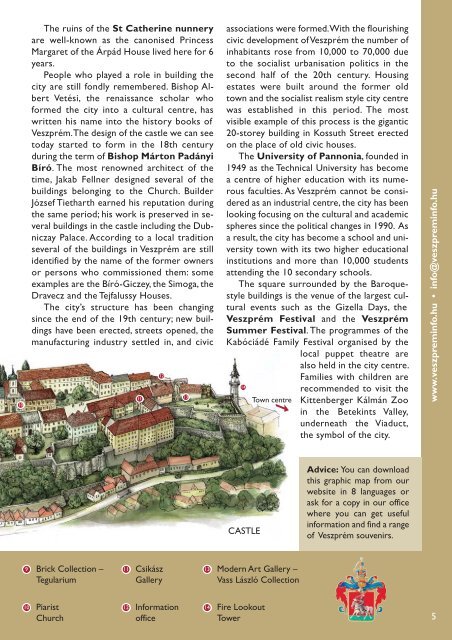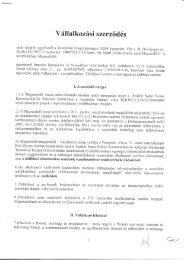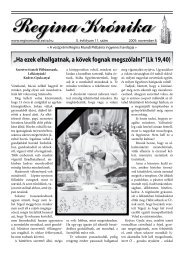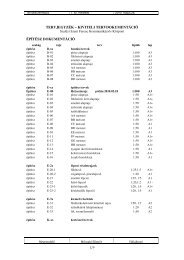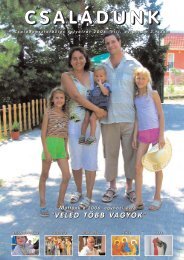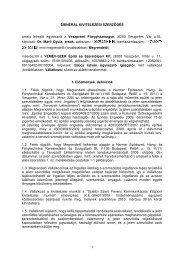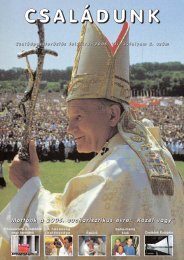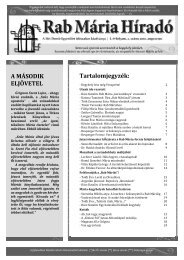Tourinform_utitars_2009_Angol2:Layout 1.qxd
Tourinform_utitars_2009_Angol2:Layout 1.qxd
Tourinform_utitars_2009_Angol2:Layout 1.qxd
Create successful ePaper yourself
Turn your PDF publications into a flip-book with our unique Google optimized e-Paper software.
10<br />
9<br />
10<br />
The ruins of the St Catherine nunnery<br />
are well-known as the canonised Princess<br />
Margaret of the Árpád House lived here for 6<br />
years.<br />
People who played a role in building the<br />
city are still fondly remembered. Bishop Albert<br />
Vetési, the renaissance scholar who<br />
formed the city into a cultural centre, has<br />
written his name into the history books of<br />
Veszprém. The design of the castle we can see<br />
today started to form in the 18th century<br />
during the term of Bishop Márton Padányi<br />
Bíró. The most renowned architect of the<br />
time, Jakab Fellner designed several of the<br />
buildings belonging to the Church. Builder<br />
József Tietharth earned his reputation during<br />
the same period; his work is preserved in several<br />
buildings in the castle including the Dubniczay<br />
Palace. According to a local tradition<br />
several of the buildings in Veszprém are still<br />
identified by the name of the former owners<br />
or persons who commissioned them: some<br />
examples are the Bíró-Giczey, the Simoga, the<br />
Dravecz and the Tejfalussy Houses.<br />
The city’s structure has been changing<br />
since the end of the 19th century; new buildings<br />
have been erected, streets opened, the<br />
manufacturing industry settled in, and civic<br />
Brick Collection –<br />
Tegularium<br />
Piarist<br />
Church<br />
11<br />
12<br />
11<br />
12<br />
Csikász<br />
Gallery<br />
Information<br />
office<br />
13<br />
13<br />
14<br />
associations were formed. With the flourishing<br />
civic development of Veszprém the number of<br />
inhabitants rose from 10,000 to 70,000 due<br />
to the socialist urbanisation politics in the<br />
second half of the 20th century. Housing<br />
estates were built around the former old<br />
town and the socialist realism style city centre<br />
was established in this period. The most<br />
visible example of this process is the gigantic<br />
20-storey building in Kossuth Street erected<br />
on the place of old civic houses.<br />
The University of Pannonia, founded in<br />
1949 as the Technical University has become<br />
a centre of higher education with its numerous<br />
faculties. As Veszprém cannot be considered<br />
as an industrial centre, the city has been<br />
looking focusing on the cultural and academic<br />
spheres since the political changes in 1990. As<br />
a result, the city has become a school and university<br />
town with its two higher educational<br />
institutions and more than 10,000 students<br />
attending the 10 secondary schools.<br />
The square surrounded by the Baroquestyle<br />
buildings is the venue of the largest cultural<br />
events such as the Gizella Days, the<br />
Veszprém Festival and the Veszprém<br />
Summer Festival. The programmes of the<br />
Kabóciádé Family Festival organised by the<br />
local puppet theatre are<br />
also held in the city centre.<br />
Families with children are<br />
14<br />
recommended to visit the<br />
Town centre Kittenberger Kálmán Zoo<br />
in the Betekints Valley,<br />
underneath the Viaduct,<br />
the symbol of the city.<br />
CASTLE<br />
Modern Art Gallery –<br />
Vass László Collection<br />
Fire Lookout<br />
Tower<br />
Advice: You can download<br />
this graphic map from our<br />
website in 8 languages or<br />
ask for a copy in our office<br />
where you can get useful<br />
information and find a range<br />
of Veszprém souvenirs.<br />
www.veszpreminfo.hu • info@veszpreminfo.hu<br />
5


